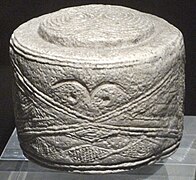Folkton drums
The Folkton drums ( English Folkton drums ) were found in 1889 by William Greenwell (1820-1918) in an oval children's grave on the Folkton Wold, south of Folkton in East Yorkshire in England in a late Neolithic round hill (Folkton Barrow) with two ring trenches. The burial mound was less than a meter high when it was excavated.
description
The find consists of three small limestone drums with diameters of 14.6, 12.7 and 10.2 cm and heights of 11.8, 10.5 and 8.6 cm. The use of "Magne Limestone" instead of the originally published chalk would mean that they came from a distance of about 70 km, near Ripon in the northwest in County Durham, where the closest outcrops of Magne Limestone are. It would also imply a higher level of scribing as Magne Limestone is much harder than chalk. The tops of the drums appear to form lids.
decoration
The sides are decorated with lines and angles and with shapes that are interpreted as human faces. The floor is undecorated. The technique may have come from wood decorations that have not been preserved. It is reminiscent of the chip carving used by joiners . The decoration is arranged in panels. Stylized owl-like faces can be seen on two of the drums. The meaning of the ornament is unknown, but similar to that found on late Neolithic Grooved Ware . The stylized faces are reminiscent of Iberian models. The geometric patterns are also reminiscent of early Bronze Age gold plates, which are decorated in the same way. Although the objects were found in Yorkshire, they are an example of late Neolithic and early Bronze Age art such as the Clandon-Barrow diamond , but mostly found in the Wessex culture several hundred miles away .
- Folkton drums
literature
- Ian Longworth: The Folkton Drums unpicked. In: Rosamund Cleal, Ann MacSween (Ed.), Grooved Ware in Britain and Ireland (= Neolithic Studies Group Seminar Papers. Vol. 3). Oxbow Books, Oxford 1999, ISBN 1-900188-77-5 , pp. 83-88.
- David V. Clarke, Trevor G. Cowie, Andrew Foxon: Symbols of power at the time of Stonehenge. HMSO, Edinburgh 1985, ISBN 0-11-492455-4 .
- Andrew Middleton, Jeremy R. Young, Janet Ambers: The Folkton Drums: chalk or cheese? Antiquity Volume 78, No 299, 2004 [1]
Web links
Individual evidence
- ↑ TA05917775



